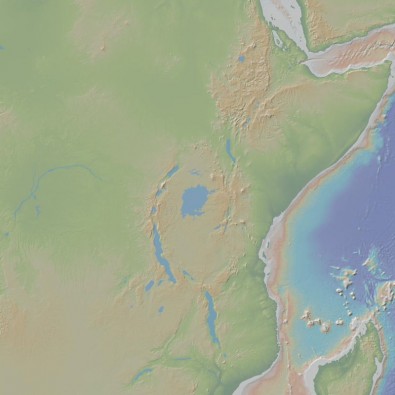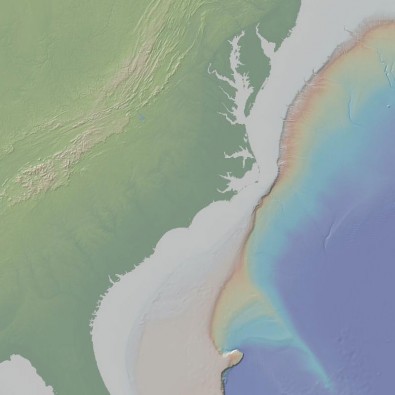The GeoPRISMS RIE Initiative focus on the fundamental processes active within rifts and rifted margins, from the initial localization of continental rupture, the structural, magmatic, and sedimentary processes that control the growth of rift zones, through the late stages of rifting and the transition to oceanic spreading and the resulting stratigraphic and tectonic architecture of passive margins. This initiative emphasizes the interactions between climate, erosion and sediment transport, and deposition and plate boundary deformation, including mantle dynamics to gain a comprehensive understanding of lithospheric evolution along rifted margins.
Maps generated using GeoMapApp.
Click on each theme below to see current projects and some remarks on that theme from the GeoPRISMS Implementation Plan.
Far-field extensional forces may be oriented at oblique angles to pre-existing structural and compositional heterogeneities in the lithosphere, such that extension is accommodated by the development of an oblique rift. Oblique extension will impact the evolution of tectonic and magmatic segmentation, as well as extensional style throughout the lithosphere, although it remains unclear to what degree the mismatch between pre-existing lithospheric fabrics and extensional stress control the development of such features. It also remains unclear how the orientation of faults and magmatic intrusions evolve over the life of the rift to produce orthogonal structures at the eventual mid-ocean ridge. This theme focuses on probing lithospheric structure, and in particular magmatic and tectonic features, in a variety of environments where oblique extension of varying magnitudes may be active. Oblique extension, for example, may result in the development of segmented en-echelon rift border faults and/or magmatic belts on the rift floor.
The selected GeoPRISMS primary sites, the East African Rift System (EARS) and Eastern North American Margin (ENAM) incorporate a significant range in extensional morphologies including oblique segments, but these rifts constitute dominantly orthogonal rift systems, and thus provide end-members to address the fundamental concept of strain localization and how it may be impacted by obliquity in terms of extension. Comparative, targeted studies of rifts incorporating a range of obliquity and magmatic activity are required to investigate variations in processes with obliquity (e.g., Gulf of California-Walker Lane). Magmatic and tectonic features preserved within variably oblique rifts may provide evidence of how shifting stress fields may manifest within primary sites and their impact on strain localization. Such studies should take advantage of existing datasets from the MARGINS program as well as other US and international programs by synthesizing previously acquired data, providing key missing datasets (e.g., structural observations, reinterpretations of lithospheric structure from existing seismic studies, geochemical investigations of magmatic plumbing system dynamics) in otherwise well-studied oblique rifts, and through numerical modeling and analogue experiments.
Numerical models indicate that strain rate is a key parameter controlling the style and magnitude of extension, efficiency of conductive cooling, and the production of magma. However, spatial and temporal patterns in strain rate are very poorly known for many extensional systems, and consequently, so are their links to deformation and magmatism. Constraints on geologically averaged strain rate during rifting at passive margins are derived from dated sediments and volcanic rocks and from magnetic anomalies associated with early seafloor spreading. GPS and InSAR data are beginning to provide the first constraints on the spatial and temporal patterns in present day strain rates in rifts. This theme focuses on integrating constraints on the temporal development of rifts with spatial patterns in deformation and magmatism, at a range of time scales, to elucidate the response of rifts to strain rate. Rifts opening at slow strain rates have been shown to accommodate deformation in unusual ways, such as through exhumation of serpentinized mantle, which could also lend important, general insights into strain accommodation in the lithosphere.
When compared with oceanic rift systems, the active EARS primary site constitutes a slow-end member, with opening rates of 1-6.5 mm/yr. Likewise, time-averaged strain-rates for the ENAM primary site have relatively slow half spreading rates of ~7 mm/yr. Focusing solely upon these relatively slowly extending systems, scaling rifting processes with strain rate is impossible. Themed studies should therefore emphasize comparisons between the GeoPRISMS primary sites, and other active and passive settings with higher strain rates, particularly those that have existing constraints on magmatism and deformation (e.g., Woodlark basin, Gulf of California-Walker Lane system, Gulf of Corinth). These studies will be directed towards illuminating linkages between strain rate and other rifting processes.
Recent work highlights the critically important role that volatiles can play in the initiation and evolution of magmatism, strain localization and other key aspects of the rifting process. The origin and abundance of volatiles likely varies significantly from plume- to slab-dominated environments and between regions with different lithospheric compositional structure. This theme will focus on complementing the datasets central to characterizing the primary sites, through studies of rifts where the volatile species or pathways may be substantially different. Evolution of rifting will depend strongly on the control volatiles exert over lithospheric rheology, and in particular the key processes controlling changes in this rheology: e.g., partial melting, sill and dike intrusion, and hydrothermal systems. Likewise, volatile exchanges with the ocean and atmosphere vary tremendously with the amounts and compositions of magmatism, interactions of magmas with sediments, and serpenitization, with implications for environmental change.
The chosen RIE primary sites, EARS and ENAM, are ideally suited to examine the role of rift maturity in controlling rift volatile reservoirs and pathways. A second constraint that is necessary to understand the volatile budget within a rift system, however, is to characterize external inputs to the rifting system. Specifically, mantle plumes and subducted slabs may provide significant concentration of volatiles but also impact/buffer the volatile species present within a rift system. While the EARS focus site provides an example of a plume-influenced rifting environment, thematic studies should seek to expand upon possible volatile sources that impact upon but are external to the rift system (e.g. subducted slab). Such studies should focus on determining the volatile characteristics (volatile species, concentration, spatial or temporal heterogeneity) in rifts where significant external control on volatile systematics has been previously demonstrated (e.g. Gulf of California), but also in rifts where unique volatile pathways or interactions have a recognized impact on rift evolution. Likewise, thematic studies should also focus on volatile exchange with the oceans and atmosphere in a variety of settings.
The volume, distribution and composition of sediments can have a dramatic impact on syn- and post-rift evolution of basins and margins at all levels of the lithosphere. In active rifts, thick sediments may enhance strain localization via thermal blanketing and reducing buoyancy contrasts and inhibit strain localization through distributed deformation. Even relatively thin sediment cover may enhance the amount and style of magmatism, while overwhelming sedimentation may inhibit magmatism or otherwise mask its contribution. On passive margins, sediment flux is likely to control the frequency of landsliding and the rates and style of deformation of the sedimentary prism. This theme focuses on integrating observations and modeling of rifting and rifted margin processes interacting over the full range of potential sediment fluxes, including overfilled conditions that are not well captured by the GeoPRISMS primary sites.
Both of the GeoPRISMS RIE primary sites exhibit low to moderate sediment flux conditions. For example, EARS basins are typically underfilled, lacustrine-dominated systems, even where these manage to capture a significant river system such as the Okavango. Although portions of the ENAM recently have been subjected to high sediment flux due to continental glaciation, overall this site is relatively starved of sediment input from large river systems. Comparative investigations should thus focus on sites subject to extremely high sediment flux during their evolution, such as where a continental-scale river crosses the rifted margin. Such studies should be limited to providing synthesis and key data sets in otherwise well-studied systems, such as how sediment from the Colorado River affects the development of northern Gulf of California MARGINS focus site or of how the Mississippi river delta influences active processes on the Gulf of Mexico passive margin. These objectives should be strongly coupled to modeling studies in order to tease out observations that can discriminate sometimes conflicting conclusions of the role of sediment flux in RIE.
Observations across time scales and various stages of seismic or magmatic cycles are needed to fully understand how distributed, dominantly elastic deformation is resolved as fault slip or genesis of new magmatic crust. This theme focuses on discrete events, such as dike injection and earthquakes, which can provide unique information on the shortest time-scale, episodic deformation and magmatic processes. Fundamental questions to be addressed with such comparative studies include what controls the sizes of rift-related earthquakes and magmatic events, and how do these relate to the development of border faults and rift segmentation. This theme also includes discrete events at passive margins, addressing questions such as what triggers large landslides and rare earthquakes in these settings. Although both GeoPRISMS primary sites are well suited to capture such events, their inherently unpredictable nature warrants a complimentary thematic approach. Comparative studies under this theme should be geared towards rapid, nimble, and focused amphibious scientific response to rare rift and rift-margin events, no matter where these may occur but with preference for the primary sites when possible. Additional comparative studies could include modeling and synthesis of observations from well-studied examples of rift earthquakes and landslides that lie outside of the primary sites.
The key questions guiding this initiative are:
- Where and why do continental rifts initiate?
- How do fundamental rifting processes (such as tectonics, magmatism, and erosion, transport, and sedimentation), and the feedbacks between them, evolve in time and space?
- What controls the architecture of rifted continental margins during and after breakup?
- What are the mechanisms and consequences of fluid and volatile exchange between the Earth, oceans, and atmosphere at rifted continental margins?
RIE
- Vignettes from the Salton Seismic Imaging Project: Student Field Work Experiences
- Rupturing Continental Lithosphere in the Gulf of California & Salton Trough
East African Rift System
- Mini-Workshop Report | From rifting to drifting: evidence from rifts and margins worldwide
- Workshop Report | NSF-GeoPRISMS Rift Initiation and Evolution Theoretical and Experimental Institute
- Spotlight | Complex upper mantle structure beneath the East African Rift System
- Spotlight | A continent-scale geodetic velocity field for East Africa
- Spotlight | Constraining variability in mantle CO2 flux along the East African Rift System
- Spotlight | Investigating mantle controls on volcano spacing along the East African Rift System
- From rifting to drifting: evidence from rifts and margins worldwide mini-workshop
- Conference Report | Magmatic Rifting and Active Volcanism, Afar Rift Consortium (Addis Ababa, Ethiopia)
- Report from the Field | Welcome to a field season at Ledi-Geraru, Afar, Ethiopia!
- Workshop Report | GeoPRISMS Planning Workshop for East African Rift System
- Mini-Workshop Report | Collaborative Efforts in the East African Rift System
Eastern North American Margin
- Workshop Report | NSF-GeoPRISMS Rift Initiation and Evolution Theoretical and Experimental Institute
- Late Stage Rifting and Early Seafloor Spreading History of the Eastern North American Margin
- Volcanoes of Virginia: A Window into the Post Rift Evolution of the Eastern North American Margin
- From the Mudline to the Mantle: Investigating the Eastern North American Margin
- U.S. Earth Scientists Prepare for a Community Seismic Experiment at the ENAM Primary Site
- Workshop Report: EarthScope – GeoPRISMS Science Workshop for Eastern North America (ENAM)



